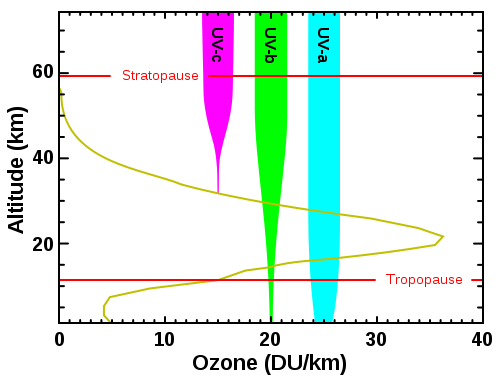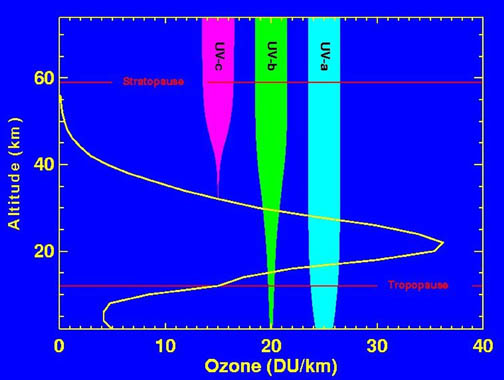Rikcha:Ozone altitude UV graph.svg

Tamaño de esta previsualización PNG del archivo SVG: 504 × 380 iñu. Huk huyakukuna: 318 × 240 iñu | 637 × 480 iñu | 1019 × 768 iñu | 1280 × 965 iñu | 2560 × 1930 iñu.
Qallariy willañiqi (SVG willañiqi, rimasqakama 504 × 380 iñuyuq, willañiqip chhikan kaynin: 20 kB)
Willañiqip wiñay kawsaynin
P'unchaw/pacha nisqapi ñit'iy chaypacha willañiqi kachkasqata qhawanaykipaq.
| P'unchaw/Pacha | Uchuylla rikchacha | Chhikanyachikuqkuna | Ruraq | Willapuy | |
|---|---|---|---|---|---|
| kunan | 02:18 21 ini 2011 |  | 504 × 380 (20 kB) | Hardwigg | == Summary == {{Information |Description=Levels of ozone at various altitudes, and related blocking of several types of ultraviolet radiation. The ozone concentrations shown are very small, typically only a few mol |
Maypim willañiqita llamk'achinku
Kay rikchamanqa kay qatiq p'anqam t'inkimun:
Mayqin wikikunapi willañiqita llamk'achinku
Kay wakin wikikunam willañiqitaqa llamk'achinku:
- ast.wikipedia.org-pi kaykunapi llamk'achinku
- ba.wikipedia.org-pi kaykunapi llamk'achinku
- be.wikipedia.org-pi kaykunapi llamk'achinku
- bn.wikipedia.org-pi kaykunapi llamk'achinku
- ca.wikipedia.org-pi kaykunapi llamk'achinku
- cy.wikipedia.org-pi kaykunapi llamk'achinku
- da.wikipedia.org-pi kaykunapi llamk'achinku
- de.wikipedia.org-pi kaykunapi llamk'achinku
- el.wikipedia.org-pi kaykunapi llamk'achinku
- en.wikipedia.org-pi kaykunapi llamk'achinku
- en.wikiversity.org-pi kaykunapi llamk'achinku
- es.wikipedia.org-pi kaykunapi llamk'achinku
- eu.wikipedia.org-pi kaykunapi llamk'achinku
- fr.wikibooks.org-pi kaykunapi llamk'achinku
- ia.wikipedia.org-pi kaykunapi llamk'achinku
- id.wikipedia.org-pi kaykunapi llamk'achinku
- it.wikipedia.org-pi kaykunapi llamk'achinku
- kn.wikipedia.org-pi kaykunapi llamk'achinku
- ks.wikipedia.org-pi kaykunapi llamk'achinku
- lb.wikipedia.org-pi kaykunapi llamk'achinku
- mk.wikipedia.org-pi kaykunapi llamk'achinku
- mn.wikipedia.org-pi kaykunapi llamk'achinku
- pl.wikipedia.org-pi kaykunapi llamk'achinku
- pt.wikipedia.org-pi kaykunapi llamk'achinku
- ru.wikipedia.org-pi kaykunapi llamk'achinku
- ru.wikinews.org-pi kaykunapi llamk'achinku
- sv.wikipedia.org-pi kaykunapi llamk'achinku
- te.wikipedia.org-pi kaykunapi llamk'achinku
- tl.wikipedia.org-pi kaykunapi llamk'achinku
- tr.wikipedia.org-pi kaykunapi llamk'achinku
- tt.wikipedia.org-pi kaykunapi llamk'achinku
- uk.wikipedia.org-pi kaykunapi llamk'achinku
- vi.wikipedia.org-pi kaykunapi llamk'achinku
- www.wikidata.org-pi kaykunapi llamk'achinku
Qhaway mayqin wikikunapim willañiqita llamk'achinku.


